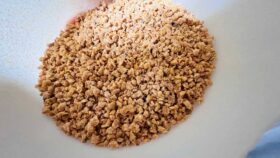Certified Organic: (US, others) To be labeled as “Certified Organic” in the US, meat and poultry must come from animals that are raised in accordance with organic farming standards. These standards typically include restrictions on the use of synthetic pesticides, herbicides, antibiotics, and genetically modified organisms (GMOs). The animals are typically raised with organic feed and have access to the outdoors.
Chemical-free: (US) A product that contains no artificial ingredients or chemical preservatives.
Free-range or Free-roaming: (International) Poultry that has been allowed access to the outside.
Free-Range or Pasture-Raised: (US, others) These terms suggest that the animals had access to the outdoors or were raised on pasture, which can offer better living conditions than confined, industrial operations.
Fresh poultry: (US) Poultry that has never been below 26°F.
Frozen poultry: (US) Poultry that has been held at 0°F or lower.
Grain-Fed: (International) This label implies that the animals were primarily fed grains or other non-grass-based diets, which is common in many commercial meat production systems.
Grass-Fed: (International) “Grass-Fed” typically means that the animals were primarily fed a diet of grass or forage throughout their lives, although some supplemental grains may be allowed. This label does not necessarily imply organic or non-GMO practices.
Halal: (International) Halal meat is prepared following Islamic dietary laws. This includes specific slaughter methods and requirements for the handling and preparation of the meat.
Kosher: (International) Kosher meat is prepared according to Jewish dietary laws and involves specific slaughtering practices and inspections.
Mechanically separated meat: (US) A paste-like meat product produced by forcing bones, with attached edible meat, under high pressure through a sieve or similar device to separate the bone from the edible meat tissue.
Natural: (US) A product containing no artificial ingredient or added color and is only minimally processed (a process which does not fundamentally alter the raw product). The label must explain the use of the term natural (such as “no added colorings or artificial ingredients; minimally processed”).
No antibiotics: (US) The terms “no antibiotics added” may be used on labels for meat or poultry products if sufficient documentation is provided by the producer to the USDA demonstrating that the animals were raised without antibiotics. If an animal becomes sick and requires antibiotics, it cannot be sold as “no antibiotics added.”
No hormones (beef): (US) The term “no hormones administered” may be approved for use on the label of beef products if sufficient documentation is provided to USDA by the producer showing no hormones have been used in raising the animals.
No hormones (pork or poultry): (US) Federal regulations prohibit the use of hormones in raising hogs and poultry.
Non-GMO: (International) A “Non-GMO” label indicates that the animals were not fed genetically modified organisms. This label may apply to both feed and the animals themselves.
Organic: (International) Meat and poultry labeled as organic must come from animals fed organic – which also means non-GMO – feed, given fresh air and outdoor access, and raised without antibiotics or added growth hormones. Organic livestock must also have access to pasture for at least 120 days per year.
Protected Designation of Origin (PDO) and Protected Geographical Indication (PGI): (EU) These labels are used to protect and promote regional and traditional foods. Meat labeled with PDO and PGI must come from specific regions and meet particular quality and production standards.
Raised without Antibiotics or Antibiotic-Free: (International) This label indicates that the animals were not treated with antibiotics during their lifetime. However, this label does not necessarily mean the animals were raised in organic or free-range conditions.
Sustainably Sourced: (International) This label may indicate that the meat was produced with a focus on environmental and ethical considerations, such as minimizing ecological impact and promoting fair labor practices.














